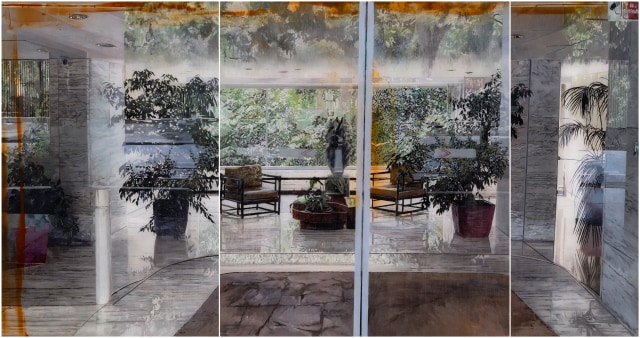For Gil Heitor Cortesão’s 5th solo exhibition with CARBON 12, À Rebours, the artist brings to life new works using his inherent technique – reverse painting on plexiglass. Translating to “backwards” in French, the title lends itself to this process as well as alludes to the eponymous book from 19th century author, Joris-Karl Huysmans. Building layer upon layer of painterly tension and reaction, there is a sense of illusion and a duality between what the viewer can see and what they can imagine might exist within these layers.
With a career spanning nearly three decades, Cortesão has honed his reverse glass process, characterized by painting on the opposite side of the transparent surface – making the more classical approach to painting, inverted. For some this may seem like a backward approach to painting since what would normally go last on a canvas is applied first in this technique. However, in his use of this method, Cortesão is able to deconstruct a scene into several levels and then carefully reconstruct it to offer a melancholic stillness.
While his works are deeply inspired by the utopian vision of 1960s and 70s architecture, as is referenced from images, postcards, and books the artist has collected over the years, Cortesão brings in a new perspective and aura of familiarity to the compositions. In these once futuristic then retro now ruined environments, the viewer still tends to feel like on outsider – an observer that is not allowed into these spaces but only permitted to witness the ongoings from the exterior, or even the interior.
Having gathered these references over the last decades, Cortesão has amassed a myriad of imagery to choose as starting points for his compositions. The selected images are usually those of spaces designed by iconic architects of a specific period and shot by famous photographers. However not all images collected necessarily give origin to a painting. Choosing the reference or starting point is a gradual process that is built over time. Somethings also tend to happen during the process.
Using textural brushstrokes that contradict the flatness of the painted planes, the sheer nature of the chosen material for Cortesão brings forth another dimension to the composition. Accidents are welcome - things start happening as the painting develops – that is the active part of the process. At first glance, Cortesão’s compositions are photorealistic and precise. Upon closer examination, we can see the smears, drips, and masks layered on the pristine image underneath.
Ideas of the uncanny – the everyday in a strange, off putting and sometimes mysterious way - makes us look at the panels closely. This brings in a new element to the paintings: the viewers’ reflections. Something becomes paradoxical for the viewer. Although they may feel like an exterior witness, they are also projected into the painting, like in a mirror. In this way, they become part of the painting as a moving reflection. The artist, as an observer himself, will also feel this push and pull from within the paintings.
Each work plays with the limits of its composition and notions of framing. In Spotless, for example, the painting somewhat becomes like a puzzle and situations of mise-en-abîme arise - paintings inside paintings, boxes inside boxes, images inside images. This work specifically centers on this idea of a painting within a painting. Hanging on the wall of this ostensibly pristine interior, a painting of a hazy, imprecise landscape. There's a subtle tension that develops with the surrounding space because of its tilting, a sense of instability that challenges the tidiness of the classically contemporary room.
What happens inside the paintings forms the relationship a work can establish with its surroundings. On one hand, Cortesão’s works provide a glimpse into the artist’s mind and the gravitational power of his obsessions. On the other hand, those same works are able to absorb the viewer into the painting and echo them back to themselves, creating an endless cycle of what is visible and what is not, what is movement and what is not. They are projected along with their memories into the space.
Leaving space for viewers to approach and interact with the works on their own terms, ideas of distance also come into play. Dimensions of mystery and what is familiar evoke a sense of nostalgia. A cinematographic quality also permeates the compositions, such as in El Ángel Exterminador. In this work, Cortesão is directly referencing the 1962 surrealist fantasy film of the same name by Spanish director Luis Bunuel. The film centers around the main character inviting friends over to an opulent dinner party, however panic and madness set in as the guests are mysteriously incapable of leaving the room.
Seemingly out of touch with reality, the works exude a feeling of a dreamscape and fantastical imagery that utters familiarity all the while offering a sense of mystery and tension. This sense that the artist creates forms an internal tautness for the viewer. Uncertain of what added value their presence brings to the landscape; the audience is still left to wonder - are they invited into these spaces or are they just an unknown spectator?
86

